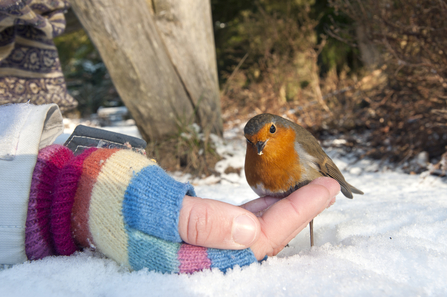What makes a great Christmas? A huge turkey? Laughs and japes while watching Miracle On 34th Street on the sofa? Leaving a cool glass of milk out for Santa? Well, for me, a delightful little bird sums it all up: the robin.
No matter how little of a birdwatcher you are, everyone knows what a robin is. Most people love them. I, for one, am enchanted by them. And even though there is a lot of fun to be had looking for ‘special’ or rare species, just look at them! Robins have the most doleful black eyes, and rich clementine coloured chests. Hopefully, this national robin day I can shed some light on these often-overlooked birds.

Robin eating out of someone's hand (credit: Alexander Mustard/2020VISION)
If you haven't seen one in real life, you will certainly have seen one on Christmas cards. A robin perched on a spade in a snowy garden is perhaps the most quintessentially British image one can think of.
Robins are extremely common in the UK, with an estimated 6,700,000 pairs nesting here. Anyone with a garden can easily attract nesting robins. They like an old wall or open-fronted nest box. They can be seen at any time of year, but in the autumn and winter their beautiful, liquid song is at its most apparent. Interestingly, the song changes due to the different seasons, being brighter and cheerier-sounding in the warmer months and melancholy in the colder. To hear it at its best, a cold, still winter evening is a special experience.
There is also a whirlwind of myth surrounding this pretty bird. Many believe that ‘when a robin is here, a loved one is near’, or that robins are a messenger from someone dear to you who has passed. So, don’t turn a blind eye to the robin redbreast, they really deserve a second glance.

